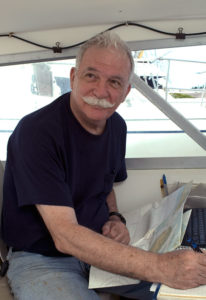
In 1979 Philip Masters, the Company’s late founder and President, moved from New York to South Florida, intent on realizing his dream of becoming involved in the search for historic shipwrecks. He soon began to conduct research in the pertinent American archives for information on various well-documented vessels lost along the US eastern seaboard. By the mid 1980’s he had begun to look for a place that had two things in common: 1) evidence of historically significant shipwreck, and 2) located in the waters of a US State that would issue a permit to legally search for the vessel. By 1985 he has begun to focus his efforts on the State of North Carolina; he had found documents indicating that El Salvador, a richly laden Spanish merchantman, had been lost near Beaufort Inlet, North Carolina in August 1750. In late 1986 he conducted further research at the Archivo General de Indias in Seville, Spain. Original documentation found there confirmed that El Salvador was indeed carrying an incredibly valuable consignment of gold and silver when she wrecked. In late 1986, application was made to the North Carolina Department of Cultural Resources (“DCR”) for a permit at Beaufort Inlet. In January 1987, the permit was issued.
Phil Masters research on QAR indicates that another historically significant vessel, Blackbeard’s 1718 flagship Queen Anne’s Revenge (QAR,) had also been lost within the same area. Following confirmation of that fact, in late 1987, application was made for a state permit covering QAR, which was granted in January 1988. A year thereafter, a second Blackbeard vessel, the pirate sloop Adventure, was added to the permit.
Initial diving reconnaissance in 1987 established that conditions in the prime target area, while not ideal, were adequate for search and salvage operations. Mr. Masters and his long-time friend Dr. Allan Fields then enlisted the aid of attorney Louis J. Pleeter, accountant Glenn R Haft, and others. In early 1988, Intersal Inc. was incorporated in Florida with an expressed goal of helping to increase knowledge and awareness of America’s rich maritime heritage by researching, locating and excavating valuable historic shipwrecks. Presentations were made to prospective investors, and funds were raised to allow for the commencement of field operations in the fall of 1988.
For approximately one month in 1988, and again in 1989, the Company conducted preliminary magnetometer survey operations in the shallower portions of the target area. Many groups of anomalies (possible shipwreck sites) were electronically pinpointed for follow-up sand removal and diving investigation. In 1990, Pelican III, a forty-two foot steel-hulled crew boat powered by two large diesel engines, was purchased, refitted, equipped with twin twenty-six inch diameter custom-built prop-wash diverters, and brought to Beaufort Inlet to begin search operations.
In 1991, questions arose as to the status of the state permits, requiring that fund-raising and field operations be suspended. In 1995, the DCR confirmed Intersal’s clear title to the permits, and field operations resumed. In 1996, guided by Mr. Masters’ research, Intersal discovered the shipwreck of Blackbeard the Pirate’s Flagship, Queen Anne’s Revenge.
